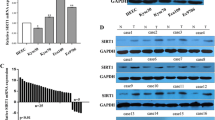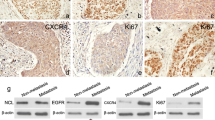Abstract
Purpose
To detect the expression levels of ubiquitin-specific protease 22 (USP22) in human esophageal squamous cell carcinoma (ESCC) and to correlate it with clinicopathologic and prognostic data.
Methods
The immunoreactivity of USP22 protein was analyzed in 157 pathologically characterized ESCC tissues by immunohistochemistry. All statistical analyses were performed with SPSS statistical software to evaluate the association of USP22 protein with clinicopathologic factors and survival.
Results
High expression of USP22 protein was detected in 50.96 % of 157 ESCC tissues and significantly associated with invasion depth, lymph node metastasis, pathologic stage and tumor relapse (P < 0.05, respectively). Univariate survival analysis showed that patients with high expression of USP22 protein had a significantly poorer 5-year disease-specific survival (P = 0.002), and multivariate survival analysis showed that high expression of USP22 protein was an independent prognosticator for unfavorable disease-specific survival (P = 0.039). Further survival analysis stratified by pathologic stage demonstrated that high expression of USP22 protein significantly predicted unfavorable clinical outcome (P = 0.029) among patients with pathologic stage IIb–III diseases.
Conclusion
USP22 protein plays an essential role in ESCC progression and has clinical potentials not only as a promising biomarker to identify the subgroup of patients with more aggressive tumors and poor prognostic potential but also as an attractively therapeutic target for ESCC.


Similar content being viewed by others
References
Djärv T, Lagergren P (2011) Six-month postoperative quality of life predicts long-term survival after oesophageal cancer surgery. Eur J Cancer 47:530–535
Enzinger PC, Mayer RJ (2003) Esophageal cancer. N Engl J Med 349:2241–2252
Glinsky GV (2006a) Integration of HapMap-based SNP pattern analysis and gene expression profiling reveals common SNP profiles for cancer therapy outcome predictor genes. Cell Cycle 5:2613–2625
Glinsky GV (2006b) Genomic models of metastatic cancer: functional analysis of death-from-cancer signature genes reveals aneuploid, anoikis-resistant, metastasis- enabling phenotype with altered cell cycle control and activated Polycomb Group (PcG) protein chromatin silencing pathway. Cell Cycle 5:1208–1216
Glinsky GV (2008) “Stemness” genomics law governs clinical behavior of human cancer: implications for decision making in disease management. J Clin Oncol 26:2846–2853
Glinsky GV, Berezovska O, Glinskii AB (2005) Microarray analysis identifies a death-from-cancer signature predicting therapy failure in patients with multiple types of cancer. J Clin Invest 115:1503–1521
Hamilton SR, Aaltonen LA (2000) Tumours of the digestive system In: pathology and genetics, world health organization classification of tumours. IARC Press, Lyon, pp 10–25
Law S, Kwong DL, Kwok KF et al (2003) Improvement in treatment results and long-term survival of patients with esophageal cancer: impact of chemoradiation and change in treatment strategy. Ann Surg 238:339–347
Lee HJ, Kim MS, Shin JM et al (2006) The expression patterns of deubiquitinating enzymes, USP22 and Usp22. Gene Expr Patterns 6:277–284
Li SH, Wang Z, Liu XY et al (2007) Lymph node micrometastasis: a predictor of early tumor relapse after complete resection of histologically node-negative esophageal cancer. Surg Today 37:1047–1052
Liu WL, Guo XZ, Zhang LJ et al (2010a) Prognostic relevance of Bmi-1 expression and autoantibodies in esophageal squamous cell carcinoma. BMC Cancer 10:467–478
Liu Y, Yang Y, Xu H et al (2010b) Implication of USP22 in the regulation of BMI-1, c-Myc, p16INK4a, p14ARF, and cyclin D2 expression in primary colorectal carcinomas. Diagn Mol Pathol 19:194–200
Liu YL, Yang YM, Xu H et al (2010c) Increased expression of ubiquitin-specific protease 22 can promote cancer progression and predict therapy failure in human colorectal cancer. J Gastroenterol Hepatol 25:1800–1805
Liu YL, Yang YM, Xu H et al (2011) Aberrant expression of USP22 is associated with liver metastasis and poor prognosis of colorectal cancer. J Surg Oncol 103:283–289
Lv L, Xiao XY, Gu ZH et al (2011) Silencing USP22 by asymmetric structure of interfering RNA inhibits proliferation and induces cell cycle arrest in bladder cancer cells. Mol Cell Biochem 346:11–21
Mariette C, Balon JM, Piessen G et al (2003) Pattern of recurrence following complete resection of esophageal carcinoma and factors predictive of recurrent disease. Cancer 97:1616–1623
Zhang XY, Varthi M, Sykes SM et al (2008a) The putative cancer stem cell marker USP22 is a subunit of the human SAGA complex required for activated transcription and cell-cycle progression. Mol Cell 29:102–111
Zhang XY, Pfeiffer HK, Thorne AW et al (2008b) USP22, an hSAGA subunit and potential cancer stem cell marker, reverses the polycomb-catalyzed ubiquitylation of histone H2A. Cell Cycle 7:1522–1524
Zhang Y, Yao L, Zhang X et al (2011) Elevated expression of USP22 in correlation with poor prognosis in patients with invasive breast cancer. J Cancer Res Clin Oncol 137:1245–1253
Acknowledgments
This project was supported by the National Natural Science Foundation of China (No. 81172161 to Zhou Wang).
Conflict of Interest
We declare that we have no conflict of interest.
Author information
Authors and Affiliations
Corresponding author
Rights and permissions
About this article
Cite this article
Li, J., Wang, Z. & Li, Y. USP22 nuclear expression is significantly associated with progression and unfavorable clinical outcome in human esophageal squamous cell carcinoma. J Cancer Res Clin Oncol 138, 1291–1297 (2012). https://doi.org/10.1007/s00432-012-1191-5
Received:
Accepted:
Published:
Issue Date:
DOI: https://doi.org/10.1007/s00432-012-1191-5




